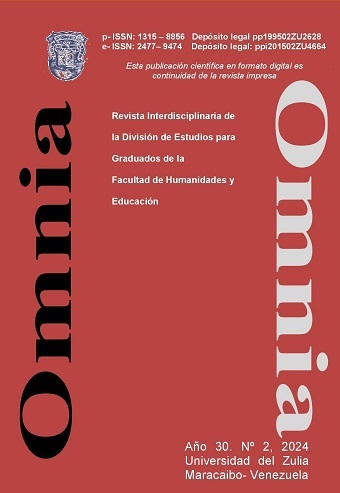Teaching tools virtual learning in students of the Samuel Robinson experimental university of teaching in Zulia State
Abstract
The new generation of Information and Communication Technologies (ICT) constitute a learning tool, allowing the integral development of knowledge and giving opportunity to research through the different networks, also allowing easy access and in a didactic way, and the interaction between teacher and student. Objective: to determine if the virtual didactic tools favor the learning of postgraduate students of the Samuel Robinson National Experimental University of Teaching in Zulia State. Method: Descriptive study, whose population consisted of 120 postgraduate students from the Samuel Robinson National Experimental Teaching University in Zulia, to whom a survey-type instrument was applied, which were analyzed using a qualitative-quantitative method. Result: 47% of students agree that virtual teaching tools favor learning, with WhatsApp being the most used tool (43%). Conclusion: Teaching students and teachers to use information and communication technologies (ICT) has not been of greater importance for the National Experimental University of Venezuelan Teachers, despite the fact that we are immersed in virtual networks. Improving education through learning tools must be the primary commitment.
Downloads
References
Bello, Rafael (2005). Educación virtual: aulas sin paredes. Recuperado el 1ero de noviembre, 2008 http://www.educar.org/articulos/educacion-virtual.asp.
Boneu, Josep (2007). Plataformas abiertas de e-learning para el soporte de contenidos educativos abiertos. Rev. U. Soc. Conocimiento, 4, 36.
Brito Rondón, Viviana (2004). El foro electrónico: una herramienta tec-nológica para facilitar el aprendizaje colaborativo. Edutec: Revista electrónica de tecnología educativa, (17), 3.
De Corte, Erik (1990). Aprender en la escuela con las nuevas tecnolo-gías de la información: perspectivas desde la psicología del aprendizaje y de la instrucción. Comunicación, lenguaje y educa-ción, 2(6), 93-112.
La Rocca, Renata y Almenara, Julio (2013). Usos del e-learning en la Universidad Metropolitana: estado de la situación y análisis de buenas prácticas. In Anales de la Universidad Metropolitana (Vol. 13, No. 2, pp. 39-64). Universidad Metropolitana.
Loaiza, Roger (2002). Facilitación y capacitación virtual en América Latina. Revista Quaderns Digitals, 28(85), 154.
Malhotra, S., y Goyal, Anil (2013). Role of online education in modern education system. International Journal of Research in Manage-ment & IT, 1(1), 6-20.
Moll, Luis (1990). Vygotsky y la Educación. Buenos Aires: Aique.
Ramírez, Tulio y Salcedo, Audy (2015). La visibilidad de la universidad venezolana según datos del ranking Scimago 2015. El Anuario Ininco/Investigaciones de la Comunicación, 27, 253-277. Anuario ININCO (27). 253-81
Salgado García, Edgar (2015). La enseñanza y el aprendizaje en moda-lidad virtual desde la experiencia de estudiantes y profesores de posgrado (Doctoral dissertation, Universidad Católica de Costa Rica).
Sánchez, L. Alvarenga, S. (2015). La virtualidad en los procesos educa-tivos: reflexiones teóricas sobre su implementación. Tecnología en Marcha, 28(1), 121-129. https://doi.org/10.18845/tm.v28i1.2196
UNESCO (2019). Declaración mundial sobre la educación superior en el siglo XXI: visión y acción. Revista Educación Superior y Socie-dad (ESS), 9(2), 97-113. Recuperado a partir de https://www.iesalc.unesco.org/ess/index.php/ess3/article/view/171São Bernardo do Campo: UNESCO – UMESP.





